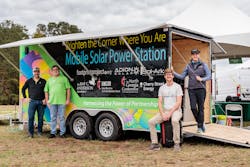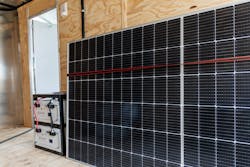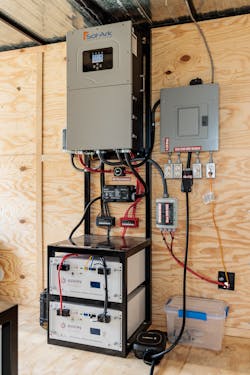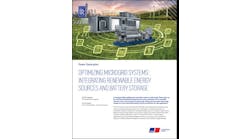New Solar Microgrid Trailer Delivers Power and Inspiration to Atlanta Communities in Need
On Oct. 15, at its ninth annual RayDay event held just outside of Atlanta, Georgia, the Ray C. Anderson Foundation debuted a new mobile microgrid.
Housed in a small cargo trailer, the mobile solar microgrid was designed to provide power for the sustainability-focused event and, in the long term, serve as a power source for Atlanta communities in need during disasters.
The solar microgrid trailer is the result of a partnership between the Ray C. Anderson Foundation, Footprint Project, Cherry Street Energy and the North Georgia Disaster Response Ministry of the United Methodist Church (UMC), all of which “share a vision of promoting a more sustainable society and a just, equitable transition to net-zero emissions,” according to a statement released by the foundation.
Powering a sustainability event sustainably
The Ray C. Anderson Foundation is named for the late industrialist and founder of Interface, a commercial carpet company. During the latter part of his life, Anderson was intensely focused on environmental stewardship and sustainability. His namesake foundation carries out his vision by funding innovation as well as educating, inspiring and connecting people in the climate space.
Launched in 2013, the foundation’s RayDay is a free event that brings together people from across the Southeastern U.S. who are interested in sustainable living. The event is held each year in Serenbe, an environmentally minded community about 30 miles outside of Atlanta.
As planning began for this year’s event, the foundation was looking for opportunities to minimize the environmental footprint that comes with hosting an event that would ultimately feature more than 60 exhibitors and more than 2,200 guests.
“We are always looking for ways with RayDay to … feature what's possible, what's happening, what's out there,” said John Lanier, executive director of The Ray C. Anderson Foundation and Anderson’s grandson. “We want each year to bring things new to the table that can deepen folks' engagement with sustainability and deepen their engagement with climate solutions,” he added.
In particular, the foundation was looking for a way to reduce its use of diesel generators during the event, which is held in a field with no built-in power infrastructure.
That, Lanier said, led them to Footprint Project, a nonprofit that provides microgrids and other emergency energy systems during disasters such as the recent Maui wildfires.
Cherry Street Energy, an Atlanta-based solar developer, was also brought on board.
The other 364 days of the year
While the three partners were excited to build the trailer both as a demonstration project and a power source for the 2023 RayDay event, there was one remaining question – how could the mobile solar microgrid best be used the other 364 days of the year?
It was Footprint Project that brought the United Methodist Church to the table.
The UMC’s Global Ministries and United Methodist Committee on Relief have been deploying mobile microgrids since 2019. The church first worked with Footprint Project in 2021, when both were responding in the aftermath of Hurricane Ida.
“The Conference Disaster Response Coordinator in Louisiana reached out looking for power for a community center without power that was providing the community with food and resources,” said the Rev. Jenny Phillips, director of environmental sustainability for the UMC’s Global Ministries. “I searched the internet for solar rentals and was lucky to discover Footprint in that search.”
Since then, Footprint Project and the UMC have partnered on solar-powered microgrid trailers in North Carolina and Florida as well as on the deployment of other solar equipment in Florida, North Carolina and Georgia.
That existing relationship made bringing the UMC into the RayDay trailer conversation a no-brainer.
Phillips suggested that UMC’s North Georgia Conference Disaster Response Team be the microgrid trailer’s long-term beneficiary, and the coalition agreed.
No need to reinvent the wheel
According to Lanier, it quickly became obvious to the foundation that there were already some well-established partnerships in the microgrid trailer space, but there wasn’t much happening in Georgia.
“We saw very clearly the idea of using our grant dollars to fund the construction of a trailer,” Lanier said. A resource like this that “could be dispatched for disaster relief efforts and meet the needs of people and communities through the power of the sun … was really appealing to us and the opportunity to show it to people at our event was exactly what RayDay is all about.”
And so, in June, a $50,000 grant from The Ray C. Anderson Foundation was awarded to Footprint Project for the construction of a solar microgrid trailer that would include a 15-kW inverter, 40 kWh of battery storage and 3 kW of mounted solar that can be expanded to 10 kW via a ground mount. Footprint Project coordinated the build with Cherry Street Energy, which also donated the solar panels.
The microgrid trailer was built in about three months by BI Production Works, a company that provides solar-powered trailer and equipment rentals to Georgia’s bustling movie industry. “Because of the writers’ and actors’ strikes, they were able to work with us on producing this particular trailer,” Phillips said.
Sol-Ark and Adion also contributed equipment and expertise; the UMC’s Global Ministries team will provide the training necessary to operate the microgrid trailer.
A multipurpose vehicle
Rapidly deployable, the trailer can be towed to where it’s needed most. The UMC’s team will use the trailer to provide power for refrigeration, phone and computer charging, medical device charging, and other basic needs in a response and recovery situation, according to Phillips.
“In times of disaster, gaining access to a source of power is one of the most essential yet challenging parts of response and recovery,” said Roland Fernandes, chief executive of UMC’s Global Ministries. “Thanks to this partnership, responders in Georgia will be able to bring their own environmentally sustainable power source with them, providing vital emergency power without the environmental damage caused by traditional fossil fuels.”
Phillips added that when it’s not supporting emergency services, the solar microgrid trailer could be used as auxiliary power for a church or community center to power outdoor events and to educate the community about sustainability technologies.
“I think that this solar microgrid trailer is one of the best ways you can show people the co-benefits that come with climate solutions,” Lanier said. “Somebody who doesn’t care one lick about reducing emissions of greenhouse gases into the environment can still see how valuable something like this is to be dispatchable to a community in need.”
“In addition to providing cleaner energy for communities in crisis, the mobile solar microgrid trailer is an outreach and education tool that can be used to promote and celebrate resilience,” said Jamie Swezey, program director at Footprint Project.
Lanier said that he hopes his family’s foundation isn’t the only one that sees value in this type of sustainability project. “This is something that is meant to inspire others on what's possible if you invest in creative solutions like these,” he said.











